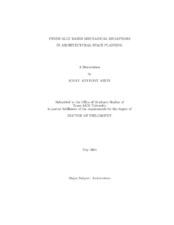| dc.description.abstract | Physically based space planning is a means for automating the conceptual design process by applying the physics of motion to space plan elements. This methodology provides for a responsive design process, allowing a designer to easily make decisions whose consequences propagate throughout the design. It combines the speed of automated design methods with the flexibility of manual design methods, while adding a highly interactive quality and a sense of collaboration with the design. The primary assumption is that a digital design tool based on a physics paradigm can facilitate the architectural space planning process. The hypotheses are that Newtonian dynamics can be used 1) to define mechanical metaphors to represent the elements in an architectural space plan, 2) to compute architectural space planning solutions, and 3) to interact with architectural space plans. I show that space plan elements can be represented as physical masses, that design objectives can be represented using mechanical metaphors such as springs, repulsion fields, and screw clamps, that a layout solution can be computed by using these elements in a dynamical simulation, and that the user can interact with that solution by applying forces that are also models of the same mechanical objects. I present a prototype software application that successfully implements this approach. A subjective evaluation of this prototype reveals that it demonstrates a feasible process for producing space plans, and that it can potentially improve the design process because of the quality of the manipulation and the enhanced opportunities for design exploration it provides to the designer. I found that an important characteristic of this approach is that representation, computation, and interaction are all defined using the same paradigm. This contrasts with most approaches to automated space planning, where these three characteristics are usually defined in completely different ways. Also emerging from this work is a new cognitive theory of design titled 'dynamical design imagery,' which proposes that the elements in a designer's mental imagery during the act of design are dynamic in nature and act as a dynamical system, rather than as static images that are modified in a piecewise algorithmic manner. | en |


